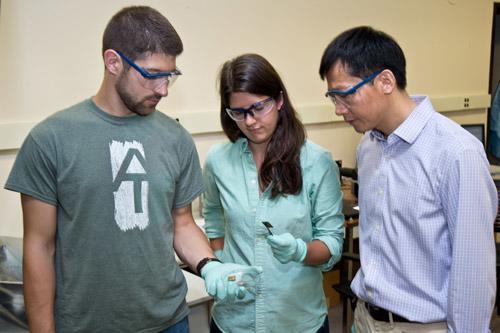MEETING TOP CHALLENGES IN SCIENCE
The world needs accessible clean water and economical solar energy. The population needs to capture carbon dioxide and to restore and improve the urban infrastructure . . . all challenges that require new materials and material systems. UMD professors and students are already working toward these goals and now there is a new program, the Materials Science and Engineering minor, which pulls together course offerings from across campus.
No one knows the importance of the program better than Taryn De Rosia and Kevin Weeks, who have taken many of the classes in the new program. They are already deep into materials science, thanks to a summer research adventure.
A TRIP TO BROOKHAVEN
The two chemical engineering students received 2015 summer awards to work on advances in solar energy for 10 weeks at the Brookhaven National Laboratory in New York. Along with Zhihua Xu, assistant professor in the Department of Chemical Engineering, Taryn and Kevin ran experiments with the goal of creating a flexible material that can capture and deliver solar energy. While it’s a research topic that is being conducted worldwide, the pair were specifically looking for a cost effective material.
Richard Davis, professor and head of the Department of Chemical Engineering, said the flexible material Taryn and Kevin are working on could be revolutionary. "A lot of the Earth is covered with pavement," he said. "Adding flexible solar cells to even a small portion of the surface would change everyone's lives." Taryn and Kevin agree. "Our work could lead to painting solar cells on buildings, cars, pavement, and other structures," Taryn said.
OPPORTUNITIES ABOUND
Kevin said the Brookhaven research experience was exciting. "The labs were amazing. We got to use high end, high resolution equipment," he said. "The right equipment at UMD would give students many, many more opportunities."
Those opportunities are important. There are a growing number of industries in the state that need graduates with materials science and engineering training.
BRINGING IT ALL TOGETHER
The Materials Science and Engineering minor is administered by the Department of Chemical Engineering. It draws from courses in the Swenson College of Science and Engineering, including Properties of Engineering Materials, Introduction to Materials Science and Engineering, Polymer Engineering, Polymer Chemistry, Biomedical Engineering, Solid State Semiconductors, Optics, etc. These courses are already being offered in Chemical Engineering, Mechanical and Industrial Engineering, Civil Engineering, Electrical Engineering, Chemistry and Biochemistry, and Physics departments.
On Sept. 10, 2015, the University of Minnesota Board of Regents approved the new program. Because the minor is made up of classes from many disciplines, students are already taking the classes. Students can transfer their credits to the minor when it officially begins in spring 2016. With the minor and a B.S. degree in any of UMD's science programs, students can apply to masters and doctoral programs in Materials Science and Engineering.
WHAT STUDENTS LEARN
The program is all about the structure, property, processing, and application of materials. That leads to a new approach to problem solving, using materials as the focus. UMD's goal is to offer a masters degree in materials science and engineering.
For more information about the Materials Science and Engineering program, contact the Department of Chemical Engineering,
Zhihua Xu, assistant professor, at 218-726-7127 or [email protected].
Richard Davis, professor and department head, at 218-726-6162 or [email protected].
